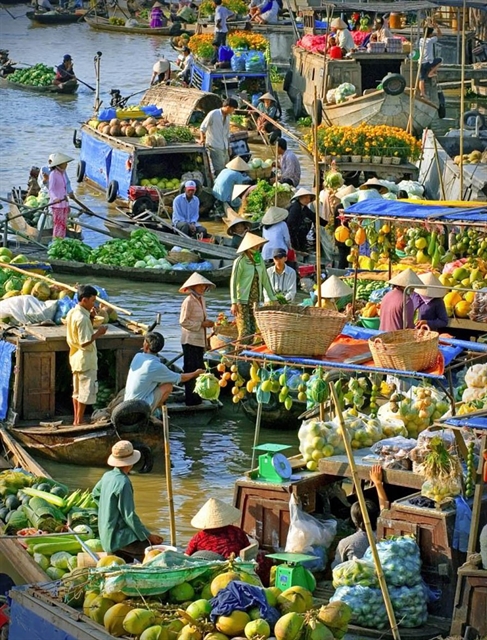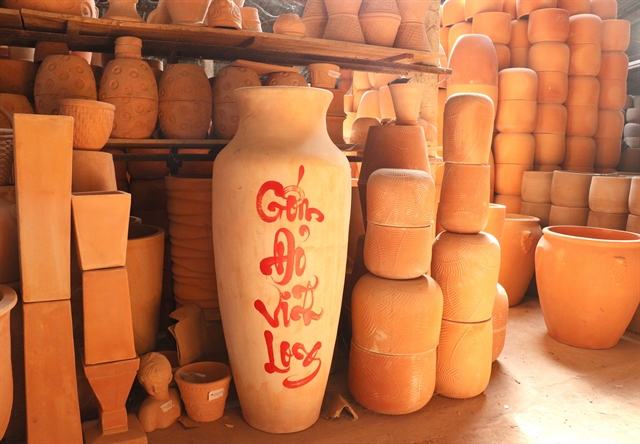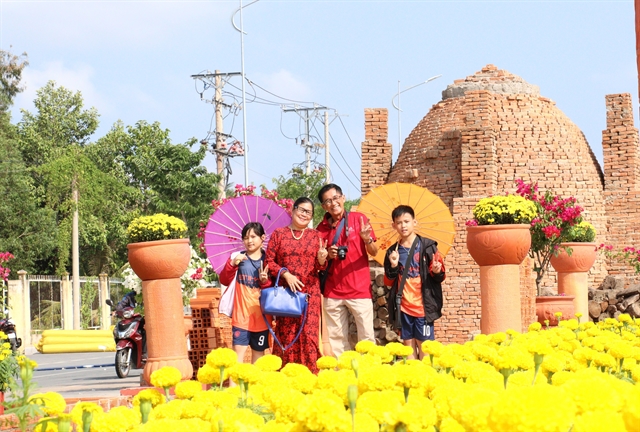 Features
Features

 |
| Vĩnh Long Province’s red ceramic products. — VNA/VNS Photos Lê Thúy Hằng |
VĨNH LONG — Vĩnh Long Province’s ceramic tile industry has recently made strong changes. Ceramic bricks are becoming more popular among domestic and foreign customers, especially in the field of tourism, which is considered one of the new directions to preserve and promote traditional brick kilns.
The province expects the ceramic tile industry to make new strides this year.
Memory
According to the Vĩnh Long People's Committee, the brick and tile manufacturing industry appeared in the locality in the early 19th century.
By the mid-twentieth century, 39 kilns in the province produced fired bricks and tiles. At that time, about 600-800 people worked in the industry.
By the early years of the 21st century, the number of brick kilns increased sharply to more than 2,200.
The ceramic industry was born in 1983 and developed strongly between 1997 and 2007.
The brick and ceramic kilns are mainly concentrated in Mang Thít and Long Hồ districts.
In its heyday, the ceramic tile industry had nearly 3,000 kilns operating all year round.
Thousands of tile and ceramic products with different designs and styles created by talented craftsmen have been favoured by customers.
In particular, recent years, ceramic products have been exported to foreign markets such as the US, Australia, Taiwan (China), Hong Kong (China), Korea and Japan.
Nguyễn Văn Buôi, owner of the Tân Hiệp Phát brick and tile production workshop in An Phước Commune, Mang Thít District, said: "With much experience, local people have been very successful in taking advantage of the traditional kilns to make pottery. The famous red brick and ceramic craft village in Vĩnh Long was also formed from there. Many businesses are enthusiastically investing in expanding production and researching to improve product making processes. Product categories are also more diverse."
However, as time goes by and society develops, the ceramic brick village of Vĩnh Long Province has faced great difficulties and challenges.
From the 2010s onwards, the ceramic brick industry began to slow down due to high production costs and low selling prices. Brick kilns began to show signs of loss, so they no longer operated with large output as before.
Some facilities have improved, but the technology of the brick and ceramic industry is still outdated with low efficiency and competitiveness.
One of the major problems of brick and ceramic production facilities is smoke and dust, because most of them still use traditional technology, causing pollution.
Environmental pollution and long firing time increase production costs and reduce competitiveness compared to modern kilns.
Many workshops that do not have enough capacity to change technology and processes gradually give up the work, leaving only a few who want to maintain the profession.
The ceramic brick village gradually became desolate.
Solutions
 |
| People excitedly take photos on the Ceramic and Spring Flower Road 2024 in Vĩnh Long City, Vĩnh Long Province. |
Facing difficulties, Vĩnh Long Province has implemented many solutions to revive the craft villages.
In 2013, it issued a project to reorganise the brick and ceramic production industry, and in 2016, it promulgated a project to improve the value chain of red ceramic production industry.
The projects offered many supportive policies such as preferential interest rate for loans to invest in production, support trade promotion and e-commerce application, and supply machinery and advanced equipment in production.
As for the results, from only 1-2 production facilities for unbaked bricks at first, by 2017 the province had 11 facilities with a total capacity of over 300 million bricks per year.
For ceramic bricks, by 2020, the province had 21 workshops.
Currently, most ceramic enterprises have applied modern technology, improving production processes and competitiveness.
The province's average output is about five million products, with an estimated value of about VNĐ400 billion (US$16.3 million) per year.
In addition to improving the quality and competitiveness of ceramic tile products, Vĩnh Long Province has approved the project "Mang Thít Contemporary Heritage".
This new initiative aims to preserve and develop traditional ceramic brick craft combined with tourism development on the basis of exploiting existing ceramic brick kilns.
To implement this project, the province has issued a specific support policy for preserving brick and ceramic kilns.
Accordingly, the 3,000-hectare heritage area with 653 kilns will be preserved by local people.
The initiative has been widely welcomed by the people, especially craft villagers.
Vĩnh Long Province hopes that the locality will become an attractive tourist destination, promoting craft villages as a new feature in the province’s cultural identities.
Contemporary heritage
The project "Mang Thít Contemporary Heritage" was based on the idea of exploiting the existing traditional ceramic brick kilns to develop tourism, while conserving their traditional cultural value.
The project covers Mỹ An, Mỹ Phước, Nhơn Phú and Hòa Tịnh communes.
Director of the provincial Department of Culture, Sports and Tourism Phan Văn Già said that the project’s goal is to turn the localities into a contemporary heritage complex, a destination on the regional tourism map.
The effort is in accordance with local sustainable socio-economic development strategy on the basis of intensifying the unique cultural values.
The project will help people in the region transform their livelihoods and improve their lives.
Dương Chí Hiền, who lives in Nhơn Phú Commune, has cherished the idea of building a red ceramic coffee shop next to the Thầy Cai Canal. The cafeteria will be decorated mainly with bright red bricks and ceramics.
Guests standing on the upper floor can admire the surrounding scenery with kilns located close together.
Accompanying ceramic tile manufacturing businesses in recent times, the provincial Ceramic Tile Association and local authorities have played a major role.
The province has been widely promoting the image of ceramic tile products through a series of events: the Việt Nam Agricultural Product Festival Vĩnh Long 2023, the Vĩnh Long Tourism Festival 2023, and the Ceramic and Spring Flower Road 2024.
Chairwoman of the Vĩnh Long Ceramic Tile Association Đoàn Thị Ngọc Diệp said that through strong promotion, ceramic tile products have become known to many domestic and foreign customers.
With new directions, this year the association will continue to research and improve technology to enhance productivity and quality, and limit environmental pollution.
Deputy Chairman of the provincial People's Committee Nguyễn Văn Liệt said that to expand red ceramic products with unique characteristics, Vĩnh Long Province would implement policies and support projects for businesses.
The province will help ceramic businesses to research and improve technology to reduce costs and increase product competitiveness.
In addition, the province also supports businesses to directly export red ceramic products instead of going through intermediaries like before.
The enterprises will increase e-commerce application in trading to expand domestic and foreign consumption markets. — VNS




